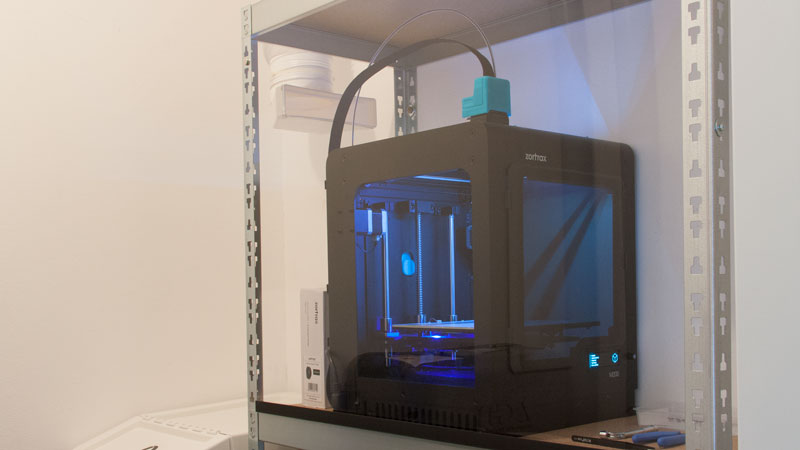A lot of work has gone into hacking common items (like IKEA Lack tables) into useful and effective 3D printer enclosures, but [Stefan.Lu] has taken a harder look at the whole business. He decided to start with some specific goals that were unmet by current solutions. In particular, he wanted to allow for proper ventilation and exhaust. Not only do some filaments smell bad, but there is ongoing research around UFP (ultra-fine particles) emitted from the 3D printing process. Just in case UFPs turn out to be this generation’s asbestos or something equally terrible, [Stefan.Lu] felt that a bit more work and expense up front would be worth it to meet his goals of a ventilation-friendly enclosure.
In addition to ventilation and exhaust, [Stefan.Lu] wanted to locate the printer at a comfortable working height, and preferred not to build things entirely from scratch. He did it for well under $200 by using a common storage rack shelf as the foundation and acrylic panels for the sides, and a few thoughtful uses of basic hardware. The angled metal supports made for easy attachment points and customization, and a combination of solid shelf plus anchoring to the wall put an end to vibrations. The side panels are secured by magnets, and [Stefan.Lu] points out that if you don’t have access to a laser cutter, cast acrylic withstands drilling and cutting better than extruded acrylic.
The final touch was a fire alarm, which is an excellent precaution. 3D printers are heating elements with multiple moving parts and they often work unattended. It makes sense to have a fire alarm around, or at least not enclose the device in highly flammable material in the first place.
















Sorry, enclosed printers are patented. Only patent holders or their license holders are permitted to offer such a basic and safety related “upgrade”.
I thought you couldn’t patent a safety feature?
You certainly can.
The Saw Stop company was trying to push the government to mandate the feature, while not giving up their patent.
Trying to? They still are. They also sued a major competitor and blocked them from competing in the US with a cheaper, resettable safety saw.
The risk management strategy of using enclosures and local exhaust ventilation (LEV) for extraction of fumes or particulates has been around for over a hundred years. Being an engineering control, it is at the most reliable end of the hierarchy of controls in occupational health and safety management; the least reliable being administrative and behavioural controls.
If your process has a reasonably foreseeable exposure risk to workers (i.e. acrylo-nitrile, styrene or polybutadeine fumes (hot ABS…) ) and you address this risk with an enclosure with local exhaust ventilation that resembles what might be found in a workplace in the early part of the 19th century or any textbook on occupational hygiene, I fail to see how a patent could be enforced.
But you are not patenting general enclosures. This is an enclosure *for a 3D printer*, which has not been patented before and is therefore novel and patentable because prior enclosures were not for 3D printers. Thank you for the several hundred dollar patent application fee and a bunch of time (or four to give digits of legal fees) and please also pay to use our patent courts to enforce your patent and renew your patent. Or so the logic seems to go, at least in the US anyway.
Hmmm who actually patented that, I shall patent a device for weather protection of an enclosed space to enable the design and building of 3D printers in a controlled environment, then shake them down.
It has to be novel and not something a practitioner of the art would routinely implement for it to be patentable.
Anyone with a diploma in occupational health and safety management or similar qualification would if asked “what are you going to about the fumes coming off the hot plastic?” respond with “Enclose the process and add LEV”.
Regrettably, the USPTO has been known to – and continues to – issue patents for the bleeding obvious.
You might even say such a strategy is…
…patently obvious.
Seatbelts were patented.
Shoulder-strap (three-point) seatbelts. And notably not enforced because the folks at Volvo were concerned about safety more than money. Whoah.
You can patent a safety feature as long as you have 1. Money 2. Patience. 3. A good patent lawyer. 4. a novel way of achieving said safety.
Three out of four ain’t bad.
No, only enclosed printers with the motors outside the enclosure and a “flexible thermal barrier” are covered by that patent. OP’s box is fine, as are all the other enclosed printers on the market.
I paid “well under $200” for my printer. This reminds me of my pal that designed a hydraulic system for holding logs in my sawmill that only would have cost about 3X what the mill cost.
For those in the UK who want to replicate this, the same rack is sold by Lidl two or three times a year.
I have been wanting to do this forever, buy I am so paranoid that I will get it wrong and give cancer to my whole family. Are there UFP detectors, or meters?